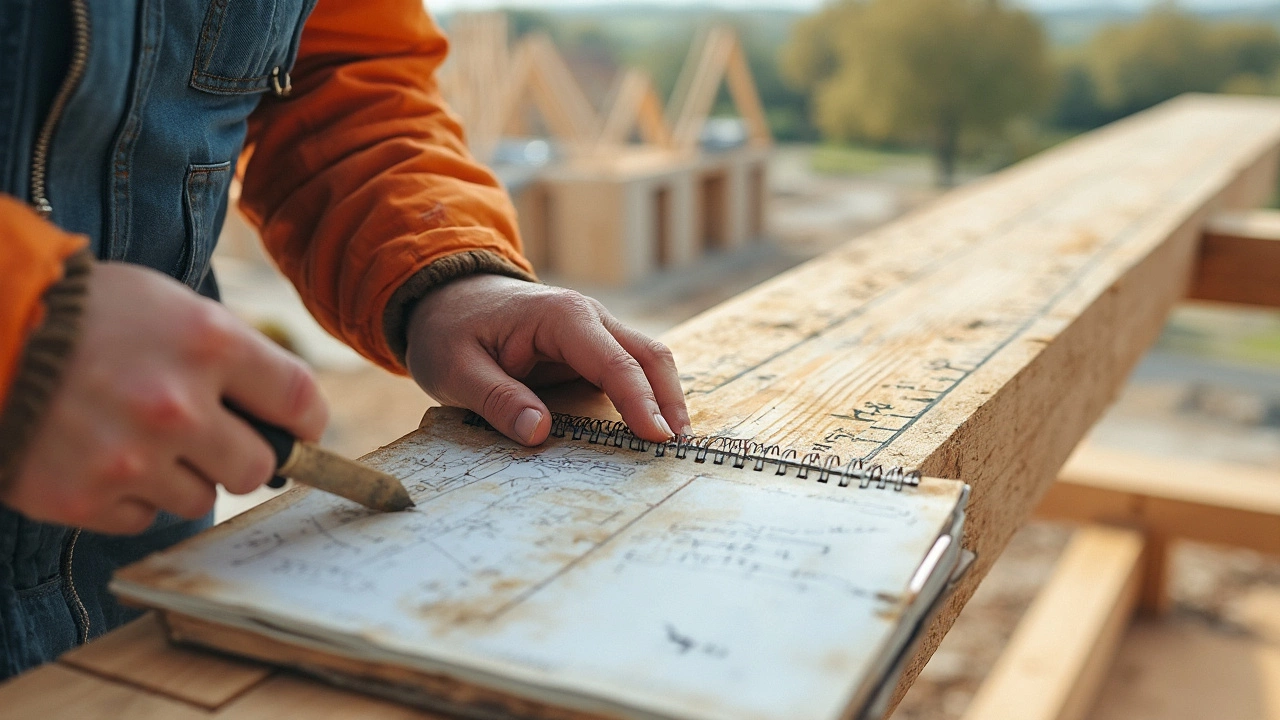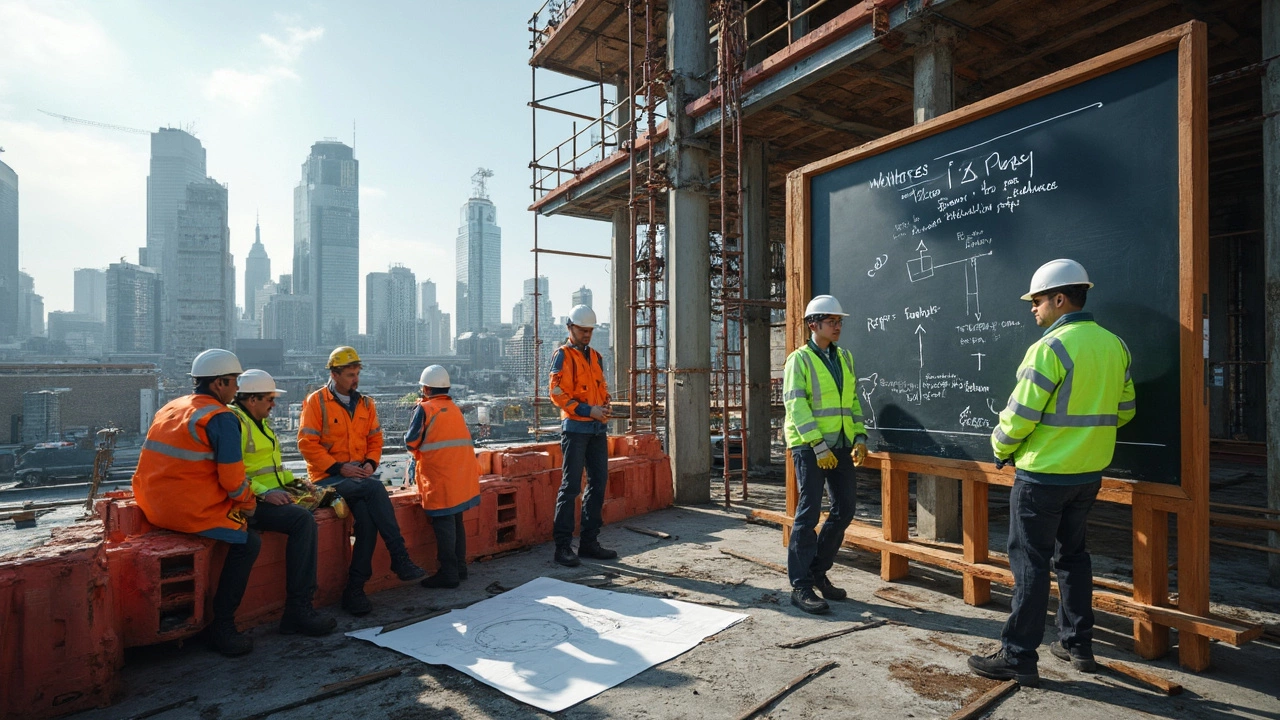The 1 3 rule pops up in a lot of commercial construction plans, and it’s not just some random guideline—it’s baked into how things stay strong and safe on site. Ever wonder why builders keep talking about one third this, one third that? It’s because the 1 3 rule keeps a bunch of projects standing tall instead of falling apart.
Basically, the 1 3 rule is a quick way to figure out the minimum depth or placement for things like footings, rebar, scaffold bases, and even backfill. Want to know how deep a footing needs to be compared to a wall’s height? Divide the wall’s height by three. Still not sure about how much rebar needs to stick into a slab? One third the length of the bar is usually the answer. These shortcuts help keep structures balanced and the workload predictable.
If you skip this rule, stuff can go wrong fast—walls crack, footings slump, or scaffolds get wonky. On a commercial site, mistakes like that mean delays, bigger bills, and a lot of finger-pointing. So getting the hang of the 1 3 rule makes life easier for everyone on the team. Let’s dig into where it pops up most, why it works, and how you can use it to build safer and smoother.
- Breaking Down the 1 3 Rule
- Where You’ll See the 1 3 Rule Used
- The Science Behind the Rule
- Common Mistakes and How to Avoid Them
- Quick Tips for Applying the 1 3 Rule On Site
Breaking Down the 1 3 Rule
The "1 3 rule" is pretty much a shortcut for safety and reliability in construction. In plain English, it means that a certain part of your build should be at least one third the size or depth of something else. It’s not just a random number—it’s the result of loads of testing and job site experience. This rule helps keep walls from tipping, footings from shifting, and rebar anchored deep enough to actually do its job.
Here’s the kicker: the 1 3 rule isn’t just for one thing. You’ll find it in a bunch of spots on commercial sites. The most common uses are:
- Footing depth: The depth of a footing should be at least one third the height of the wall it supports. So if a retaining wall is 9 feet tall, the footing goes at least 3 feet deep.
- Embedment length: Rebar or anchor bolts need to be set at least one third their length into concrete so they don’t pull out under pressure.
- Scaffold base: The width of a scaffold base should be at least one third of the height of the scaffold to help it stay upright.
This isn’t just theory. According to a 2024 survey from the National Association of Commercial Builders, over 85% of project leads said the 1 3 rule is worked into their daily checks, especially on concrete pours and scaffold setups. That’s not a small group—it shows just how trusted the rule is.
Here’s a simple data look at where the 1 3 rule gets used on job sites:
| Application | Typical 1/3 Rule Use |
|---|---|
| Footings | Depth = 1/3 of wall height |
| Rebar Anchorage | Embedded at least 1/3 length |
| Scaffold Stability | Base width = 1/3 of height |
| Backfill Behind Walls | Backfill stacked no higher than 1/3 wall height at once |
Why does it actually work? Engineers have shown that most failure points—like a footing sliding out or a scaffold tipping—happen because support is too shallow compared to height or length. The 1 3 rule gives that extra bit of insurance, so you’re not just meeting code but making the build more reliable.
Where You’ll See the 1 3 Rule Used
You’ll run into the 1 3 rule all over the place in commercial construction, especially when you’re digging, stacking, or propping things up. This rule isn’t just an old carpenter’s tale—it’s built into codes and guidelines from the American Concrete Institute (ACI) and the Occupational Safety and Health Administration (OSHA). Here’s where it shows up the most.
- Retaining Walls: The depth of a retaining wall footing should be at least one third of the wall’s exposed height. If you skip this, you risk the wall tipping or cracking over time when the soil shifts or gets saturated.
- Rebar Anchorage: When setting rebar into concrete, codes often say the bar should be embedded at least one third of its length for solid grip. Anything less, and that steel could slide out under pressure, which is a big safety issue.
- Scaffold Height: OSHA recommends that the base width of a free-standing scaffold should be at least one third of the structure’s height. Go skinnier, and the whole thing gets dicey in wind or under heavy loads.
- Backfilling Trenches: The 1 3 rule sometimes crops up when you’re backfilling near new utility lines or foundation walls. Only the bottom third should be heavy backfill right away, which helps with compaction and reduces the risk of damaging pipes or walls.
Check out this simple table that shows common spots where the rule comes into play and why:
| Application | 1 3 Rule In Practice | Why It Matters |
|---|---|---|
| Retaining Wall Footings | Footing depth = Height / 3 | Prevents tilting, supports soil load |
| Rebar Anchorage | Embed length = 1/3 bar length | Avoids pullout, improves strength |
| Scaffolding | Base width = Height / 3 | Stops tipping, adds stability |
| Backfill Next to Walls | Bottom 1/3 heavy fill first | Better compaction, fewer cracks |
On big jobs—office complexes, warehouses, hospitals—inspectors check for these ratios all the time. Forget to use the rule and you’ll likely get flagged, fined, or sent back to do expensive repairs. It’s a shortcut that keeps things safe and up to code without overthinking measurements.

The Science Behind the Rule
The 1 3 rule isn’t just some catchy shortcut—it’s about real, physical forces at play on a job site. When you hear folks talk about this rule in construction, it’s usually because of how load distribution and stability work. Say you’re setting up a footing to hold up a tall concrete wall: if the footing isn’t deep enough, the pressure from the wall could push it right over or cause cracks in the foundation.
Here’s the thing: weight and force move in predictable ways. Structures want to tip, bend, or settle where they’re weakest, and the ground underneath—well, it’s not always as solid as you’d hope. The 1 3 rule acts like insurance. By making sure footings go at least a third as deep as the height they’re supporting, you lower the risk of stuff toppling or shifting later on. A shallow base means more leverage for gravity to work its mischief; going one third in gives the soil a fighting chance to hold things steady.
It goes for reinforcement bars too. When you overlap rebar, keeping that overlap at one third the length helps the bars grab onto each other and work as a team, not as lone pieces just shoved together. If the overlap is less, cracks and breaks find weak spots. Building codes in the US and Canada specifically reference this idea when talking about overlap (also called lap splice), and it’s key for concrete to handle things like earthquakes or heavy trucks rolling by.
This rule also keeps things in check with scaffolds and soil backfill. If your scaffold legs aren’t buried enough, or you dump dirt back against a retaining wall without enough depth, the risk of a sudden slide or tip-over jumps up. A one-third measure lets the weight settle and spread out, instead of concentrating in a spot that could blow out under stress.
Almost every construction handbook repeats this because the math checks out in tests and the field. The 1 3 rule isn’t magic—it’s been proven by engineers running calculations on how forces move and what causes things to fail. If you’re not sure, just remember: deeper and longer is usually safer, but at the bare minimum, a third is what keeps the ugly surprises away.
Common Mistakes and How to Avoid Them
Even folks with lots of construction site experience mess up with the 1 3 rule once in a while. The most common slip-up? People either flat out forget to use it or think it only applies in certain situations. On a busy commercial site, skipping this step is a recipe for trouble.
One problem is not checking the specs before pouring concrete or backfilling a retaining wall. Let’s say someone thinks "close enough" is good enough when setting the depth of a footing. If it’s not at least a third of the wall’s height, settling or cracks can follow. The same thing goes for rebar—using shorter lengths just to save time or material leads to weak spots that’ll cost way more to fix later.
- 1 3 rule in footings: Never eyeball the depth. Always measure, especially when the plans change or the soil is softer than you expected.
- Backfill and retaining walls: If you don’t follow the 1 3 guide, water or soil pressure can push the wall out. Double-check your calculations before you grab the shovel or order backfill trucks.
- Scaffolding: Some crews underestimate how much base support scaffolds need. When the base isn’t at least one third the scaffold height, tipping becomes a real risk.
There’s also the issue of not training new workers on these basics. You’d be surprised how many first-timers never hear about the rule—so job leads should make it standard talk during safety meetings. Better safe than scrambling to fix preventable problems.
The easiest fix is to make the 1 3 rule a habit, just like wearing a hard hat. Keep it written on checklists, mention it in tool talks, and have someone double-check each setup. It’ll save a ton of headaches, not to mention cash and time down the road.

Quick Tips for Applying the 1 3 Rule On Site
Putting the 1 3 rule into action doesn’t need to be complicated. It’s really about remembering a few quick checks and sticking to them. Here’s how you can save yourself from headaches down the line.
- Measure Twice, Mark Once: When figuring out the depth for footings, always measure your wall height and physically mark one third of that as your minimum depth. This eliminates guessing.
- Use It With Rebar: For steel that needs to set into concrete, the rule is your friend. Say you’re using a 24-inch rebar—make sure at least 8 inches is embedded in the concrete for good bonding.
- Backfilling? Keep It Even: Don’t fill a trench more than one third at a time before compacting. It keeps the soil packed tight and prevents future dips or shifts.
- Scaffolding Stays Upright: The 1 3 rule helps figure out how much of a scaffold base should be set or anchored relative to the platform height above ground. This keeps your scaffolding from wobbling or tipping.
If you’re ever unsure, pull out your phone and punch the numbers in—there’s no shame in double-checking. Here’s what the numbers look like in real life:
| Item | Total Height/Length | 1/3 Rule Value |
|---|---|---|
| Wall | 9 ft | 3 ft (minimum footing depth) |
| Rebar | 24 in | 8 in (minimum embedded length) |
| Backfill Layer | 3 ft trench | 1 ft per pass |
| Scaffold Height | 15 ft | 5 ft (recommended anchor depth) |
One thing the pros always say: if you’re going to mess up, make it on the safe side. Or, as Mike Holmes, a trusted construction expert, puts it:
“If you want it to last, you always stick to the one-third rule for footings and supports. Anything less, and you’re gambling with trouble.”
The 1 3 rule won’t cover every scenario—local code should always be checked, and sometimes you’ll want to go beefier, especially with heavy loads or tricky soil. But for a fast safety check, this handy rule is tough to beat.





